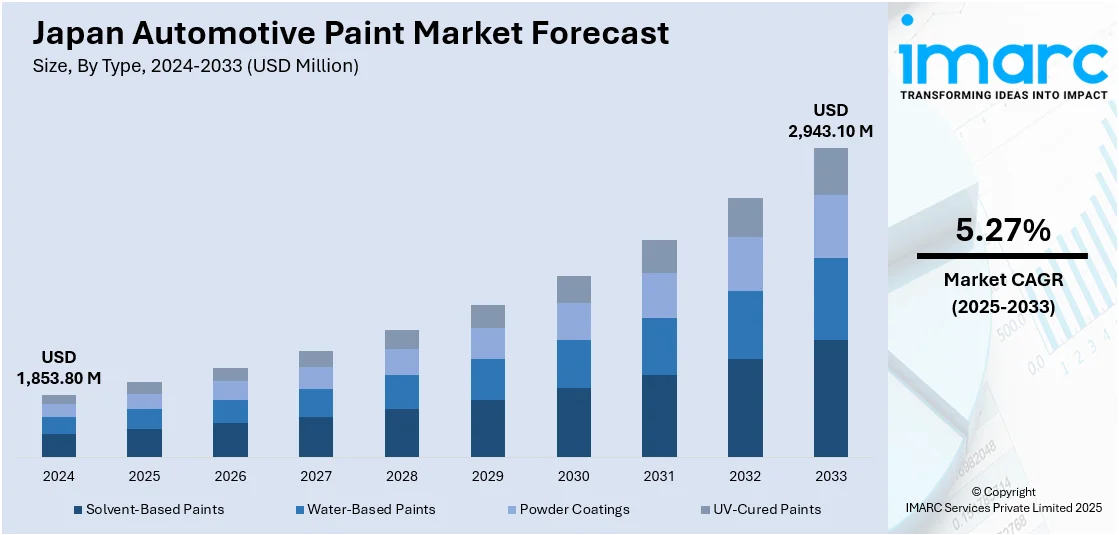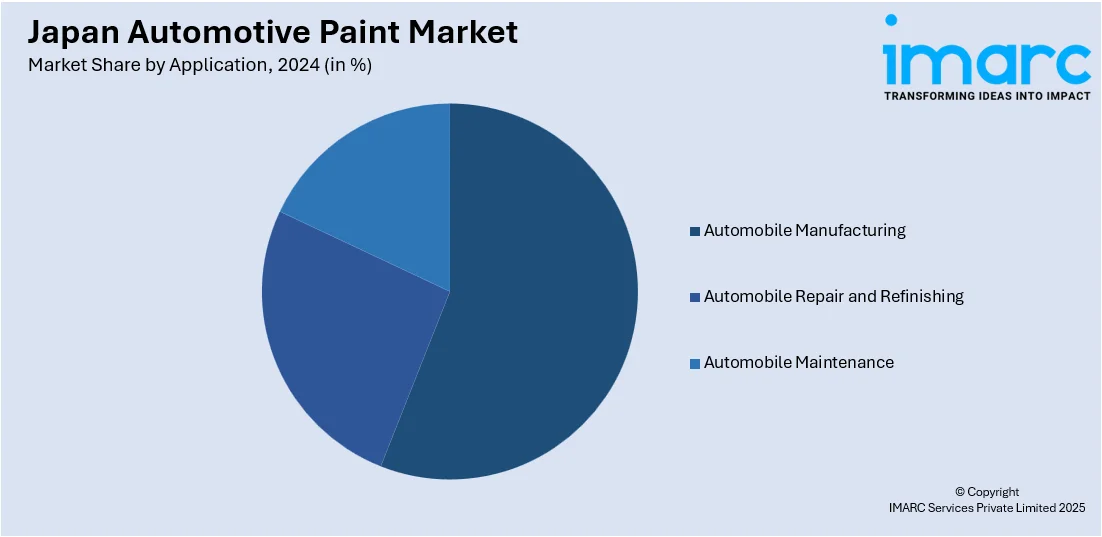
Japan Automotive Paint Market Size, Share, Trends and Forecast by Application, Type, Vehicle Type, Finish Type, and Region, 2025-2033
Japan Automotive Paint Market Overview:
The Japan automotive paint market size reached USD 1,853.80 Million in 2024. Looking forward, IMARC Group expects the market to reach USD 2,943.10 Million by 2033, exhibiting a growth rate (CAGR) of 5.27% during 2025-2033. The market is witnessing significant growth driven by advancements in eco-friendly and high-performance coatings, along with a growing emphasis on sustainability and durability. Innovations in water-based and UV-cured paints and the rising demand for automotive refinishing services are further contributing to the Japan automotive paint market share.
|
Report Attribute
|
Key Statistics
|
|---|---|
|
Base Year
|
2024 |
|
Forecast Years
|
2025-2033
|
|
Historical Years
|
2019-2024
|
| Market Size in 2024 | USD 1,853.80 Million |
| Market Forecast in 2033 | USD 2,943.10 Million |
| Market Growth Rate 2025-2033 | 5.27% |
Japan Automotive Paint Market Trends:
Growing Emphasis on Sustainability
Increased emphasis on sustainability is driving demand for lower volatile organic compound (VOC) emissions and eco-friendly automotive paints in Japan. Automotive industry players are shifting to waterborne and UV-cured paints as environmental policies are becoming more stringent, which release lower levels of toxic chemicals into the environment compared to traditional solvent-based paints. Such green paints, besides reducing VOC emissions, improve air quality and aid in overall carbon footprint reduction. Consumers are also going green and are choosing products that align with their sustainability aspirations. Paint manufacturers, in turn, are seeking to create high-performance, durable, and appearance-enhancing paints under stringent environmental regulations. For instance, in March 2025, Nippon Paint Automotive Coatings and Uchihamakasei Corp. developed Japan's first in-mold coating technology for large thermoplastic automotive parts. This innovative process, which integrates painting and molding, reduces CO₂ emissions by 60% and achieves zero VOC emissions, enhancing sustainability while maintaining high-quality design capabilities for mass production. This shift toward green paints is expected to continue growing, becoming a central factor in the Japan automotive paint market's future development.

Technological Innovation
Technological advancement is a major driver in the Japan automotive paint market, with high-performance coatings advancing the durability, scratch resistance, and appearance of automotive finishes. Companies are creating coatings that not only provide better protection against wear and tear but also enhance the overall lifespan of the vehicle's appearance. New formulations are providing better resistance to environmental stressors like UV light, harsh weather, and chemicals without compromising rich color and luster. For instance, in August 2024, Nissan is testing innovative paint technology designed to lower cabin temperatures and reduce air-conditioning energy use. Applied to an ANA service vehicle the paint has shown a 12°C exterior and 5°C interior temperature reduction. This development aims to enhance vehicle efficiency and comfort, particularly for electric and commercial vehicles. Additionally, scratch-resistant paints are getting more popular as they address the growing consumer demand for vehicles that retain their visual appeal longer. With the introduction of advanced technologies such as nanocoatings and self-healing paints, automotive paint systems are becoming more resilient and functional. These innovations are crucial for maintaining the competitive edge in the market, driving the Japan automotive paint market growth as both manufacturers and consumers prioritize quality and long-lasting finishes.
Japan Automotive Paint Market Segmentation:
IMARC Group provides an analysis of the key trends in each segment of the market, along with forecasts at the country and regional levels for 2025-2033. Our report has categorized the market based on application, type, vehicle type, and finish type.
Application Insights:

- Automobile Manufacturing
- Automobile Repair and Refinishing
- Automobile Maintenance
The report has provided a detailed breakup and analysis of the market based on the application. This includes automobile manufacturing, automobile repair and refinishing, and automobile maintenance.
Type Insights:
- Solvent-Based Paints
- Water-Based Paints
- Powder Coatings
- UV-Cured Paints
A detailed breakup and analysis of the market based on the type have also been provided in the report. This includes solvent-based paints, water-based paints, powder coatings, and UV-cured paints.
Vehicle Type Insights:
- Passenger Cars
- Commercial Vehicles
- Motorcycles
- Heavy-Duty Vehicles
A detailed breakup and analysis of the market based on the vehicle type have also been provided in the report. This includes passenger cars, commercial vehicles, motorcycles, and heavy-duty vehicles.
Finish Type Insights:
- Matte Finish
- Gloss Finish
- Satin Finish
- Metallic Finish
A detailed breakup and analysis of the market based on the finish type have also been provided in the report. This includes matte finish, gloss finish, satin finish, and metallic finish.
Regional Insights:
- Kanto Region
- Kansai/Kinki Region
- Central/Chubu Region
- Kyushu-Okinawa Region
- Tohoku Region
- Chugoku Region
- Hokkaido Region
- Shikoku Region
The report has also provided a comprehensive analysis of all the major regional markets, which include Kanto Region, Kansai/Kinki Region, Central/Chubu Region, Kyushu-Okinawa Region, Tohoku Region, Chugoku Region, Hokkaido Region, and Shikoku Region.
Competitive Landscape:
The market research report has also provided a comprehensive analysis of the competitive landscape. Competitive analysis such as market structure, key player positioning, top winning strategies, competitive dashboard, and company evaluation quadrant has been covered in the report. Also, detailed profiles of all major companies have been provided.
Japan Automotive Paint Market News:
- In March 2025, Nippon Paint Industrial Coatings was selected to supply its Target Line Paint for autonomous buses at Expo 2025 in Osaka, Japan. This specialized paint enhances navigation by improving sensor detection, especially in challenging areas. The solution promises to provide cost-effective infrastructure and improved safety for visitor transportation during the event.
- In February 2025, Yamaha Motor announced the launch of the CN1, the motorcycle industry's first carbon-neutral paint line, at its Iwata Main Factory. This all-electric system replaces fossil fuels in the painting process, enhancing sustainability and product appeal while contributing to Yamaha's goal of carbon neutrality by 2050.
Japan Automotive Paint Market Report Coverage:
| Report Features | Details |
|---|---|
| Base Year of the Analysis | 2024 |
| Historical Period | 2019-2024 |
| Forecast Period | 2025-2033 |
| Units | Million USD |
| Scope of the Report |
Exploration of Historical Trends and Market Outlook, Industry Catalysts and Challenges, Segment-Wise Historical and Future Market Assessment:
|
| Applications Covered | Automobile Manufacturing, Automobile Repair and Refinishing, Automobile Maintenance |
| Types Covered | Solvent-Based Paints, Water-Based Paints, Powder Coatings, UV-Cured Paints |
| Vehicle Types Covered | Passenger Cars, Commercial Vehicles, Motorcycles, Heavy-Duty Vehicles |
| Finish Types Covered | Matte Finish, Gloss Finish, Satin Finish, Metallic Finish |
| Regions Covered | Kanto Region, Kansai/Kinki Region, Central/Chubu Region, Kyushu-Okinawa Region, Tohoku Region, Chugoku Region, Hokkaido Region, Shikoku Region |
| Customization Scope | 10% Free Customization |
| Post-Sale Analyst Support | 10-12 Weeks |
| Delivery Format | PDF and Excel through Email (We can also provide the editable version of the report in PPT/Word format on special request) |
Key Questions Answered in This Report:
- How has the Japan automotive paint market performed so far and how will it perform in the coming years?
- What is the breakup of the Japan automotive paint market on the basis of application?
- What is the breakup of the Japan automotive paint market on the basis of type?
- What is the breakup of the Japan automotive paint market on the basis of vehicle type?
- What is the breakup of the Japan automotive paint market on the basis of finish type?
- What is the breakup of the Japan automotive paint market on the basis of region?
- What are the various stages in the value chain of the Japan automotive paint market?
- What are the key driving factors and challenges in the Japan automotive paint market?
- What is the structure of the Japan automotive paint market and who are the key players?
- What is the degree of competition in the Japan automotive paint market?
Key Benefits for Stakeholders:
- IMARC’s industry report offers a comprehensive quantitative analysis of various market segments, historical and current market trends, market forecasts, and dynamics of the Japan automotive paint market from 2019-2033.
- The research report provides the latest information on the market drivers, challenges, and opportunities in the Japan automotive paint market.
- Porter's five forces analysis assist stakeholders in assessing the impact of new entrants, competitive rivalry, supplier power, buyer power, and the threat of substitution. It helps stakeholders to analyze the level of competition within the Japan automotive paint industry and its attractiveness.
- Competitive landscape allows stakeholders to understand their competitive environment and provides an insight into the current positions of key players in the market.
Need more help?
- Speak to our experienced analysts for insights on the current market scenarios.
- Include additional segments and countries to customize the report as per your requirement.
- Gain an unparalleled competitive advantage in your domain by understanding how to utilize the report and positively impacting your operations and revenue.
- For further assistance, please connect with our analysts.
 Request Customization
Request Customization
 Speak to an Analyst
Speak to an Analyst
 Request Brochure
Request Brochure
 Inquire Before Buying
Inquire Before Buying




.webp)




.webp)












